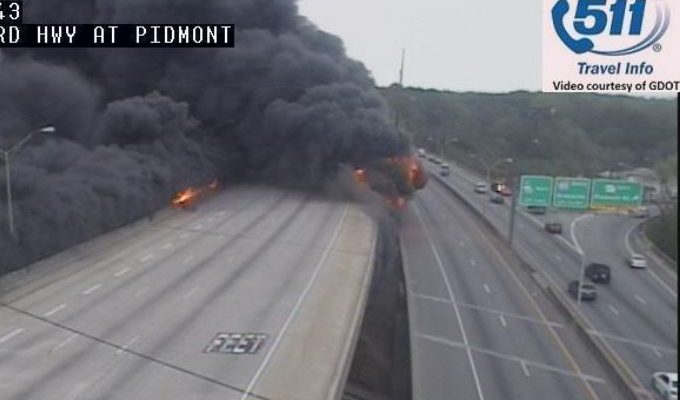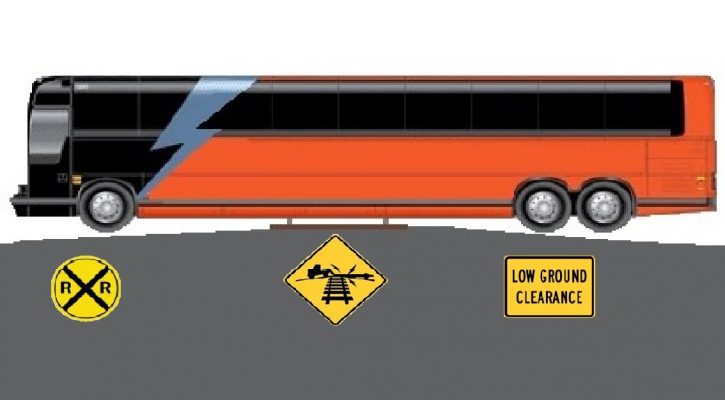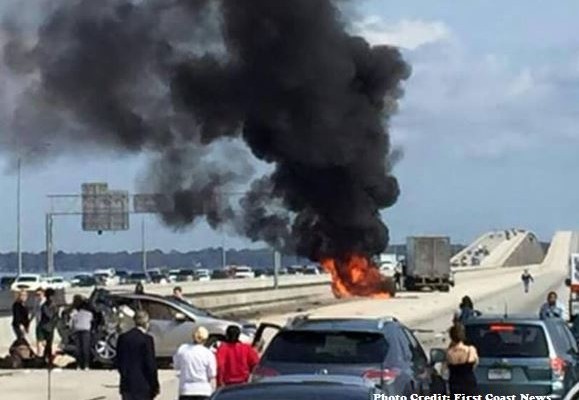Category Archive: Road Rules

To My Friends In Atlanta
March 31, 2017
The City of Atlanta suffered a crippling fire yesterday that’s going to tie up traffic in the area for months to come. A large plastic tubing storage area underneath a bridge on Interstate 85 near downtown Atlanta caught fire and the resulting heat weakened the bridge structure causing it to collapse.
Highway officials and engineers say the damage isn’t limited to just the section of bridge that collapsed but also to adjacent roadways. The bridge collapse has shut down a major artery into downtown Atlanta that carries hundreds of thousands of cars each day. Since there’s no idea yet on the extent of the damage, there’s no word on how long repairs will take. Needless to say, Atlanta traffic is going to reach even greater nightmarish levels over the coming days and months.
In past articles, I’ve written nostalgically about my early days learning to drive in the City of Atlanta. For a while, I even worked as a tour guide, driving passengers in a small bus to all the interesting sights in and around the city. In those days, Atlanta drivers took great pride in their courtesy to each other. In fact, my tourists used to comment on how courteous the drivers were in Atlanta compared to their home cities. Those days are long gone!
The explosive growth of businesses in and around Atlanta brought millions of people from other parts of the country to Atlanta in search of jobs. The population of metro Atlanta swelled from just over a million people when I graduated from high school to almost six million today. Many of those transplants from other areas of the country brought their bad driving habits with them and the folks with bad driving behaviors soon supplanted the older, more courteous native Atlantans.
Their driving behavior became so bad that Atlanta is now listed among the top cities with the worst aggressive drivers and road rage incidents according to periodic surveys by AutoVantage, an online insurance company. In fact, Atlanta passed New York and Miami in the road rage rankings.
The collapse of the I-85 bridge is going to test Atlantans in ways not seen since General Sherman’s visit in 1864. If Atlantans stick to their current driving behaviors there’s going to be a lot of chaos on Atlanta roadways. There are going to be a lot more incidents of road rage, car crashes, and, unfortunately, a lot more deaths and injuries than normal.
The only way Atlantans are going to make it through this intact is if they fall back on those old fashioned driving behaviors exhibited by Atlantans many years ago. That means;
- obeying the speed limits,
- no tailgating,
- no cutting into the front of long lines of traffic,
- no trying to beat the yellow light,
- no running red lights, and
- keeping intersections clear.
It even goes so far as to mean allowing other drivers to enter the roadway ahead of you. Allowing another driver to enter the road in front of you costs very little time and will avoid those dangerous maneuvers by drivers trying to force their way into traffic.
If Atlantans were to try this radical new idea, they’d probably be very surprised to find that traffic will flow much more quickly and smoothly. It’s the smartest and safest thing to do. If not, they should run to their hairstylist, get a Mohican haircut, put on the spiked hubcaps, and mount the harpoons and mini-Gatling guns to the hoods of their vehicles because it’s going to be just like a Mad Max movie.

Pay Attention To RR Crossing Warning Signs!
March 8, 2017
All too often, drivers either ignore railroad crossing warning signs or assume the warning doesn’t apply to them. Yesterday, four people lost their lives and seven people were critically injured after a bus that was stuck on railroad tracks was hit by a train.
This wasn’t the first crash involving a stuck vehicle and a train at that railroad crossing. Just two weeks ago, a Pepsi delivery truck became stuck at the same crossing but, fortunately, no one was injured in that crash.
Many railroad grades have steep sides that make it dangerous for vehicles such as semi-trailers and buses that have very little ground clearance. Even some cars that have been modified can become stuck at these crossings.
One of the mistakes made in this instance was that the bus driver failed to immediately evacuate the bus as soon as he became stuck. Instead, a few people got off but most remained onboard while the driver tried to move his bus off the tracks. Had the bus been evacuated and the people moved far away from the tracks, the loss of life and injuries could have been minimized.
It’s important to remember that a fully loaded freight train carrying a lot of weight can take up to a mile before it can be brought to a complete stop. When approaching railroad crossings, look at and pay attention to all of the warning signs. If you think your vehicle may not make it across, turn back and look for another nearby crossing.
For more information visit: 4 dead after train, bus collide in Biloxi, Mississippi

Time To Stop Red Light Running
August 5, 2015
August 2 – 8 is Stop On Red week and it’s a good time to stop and think about the costs of red light running. The summer vacation period is drawing to a close, Labor Day is around the corner and within the next couple of weeks, children will be returning to school. It’s time to evaluate if the time saved running a red light is worth the cost.
According to the Insurance Institute for Highway Safety (IIHS) 697 people were killed and an estimated 127,000 were injured in red light running crashes in 2013. About half of the deaths in those crashes were pedestrians, cyclists, and occupants of other vehicles that were hit by red light runners.
An IIHS study of urban crashes showed that the most common type of urban crash (22 percent) involved drivers who ran red lights, stop signs or other traffic controls. Injuries occurred in 39 percent of the crashes caused by red light runners. Drivers are more likely to be injured in a red light running crash than in any other type of urban crash.
Red light running has become an epidemic in the US. An IIHS study of 19 intersections without red light cameras in four states showed that drivers run red lights an average of 3.2 times per hour.
The National Coalition for Safer Roads (NCSR) conducted a study of red light running in the US and produced a list of the ten most dangerous cities for red light running. Those cities are:
- Houston, TX
- Phoenix, AZ
- Los Angeles, CA
- Las Vegas, NV
- Chicago, IL
- Miami, FL
- Dallas, TX
- Philadelphia, PA
- Tucson, AZ
- Denver, CO
If you want to know how bad the red light running problem is in your area, the NCSR has produced an interactive map that shows all the red light running deaths in the US between 2004 and 2013. You can choose a city to view or you can zoom in to your locality and see how many red light running deaths occurred where you live. To view the map, visit: Red-Light Running Fatality Map
To learn more, visit: Stop on Red Week 2015

Careless Driving – Not Design – Responsible For Bridge Crashes
August 3, 2015
After several horrible crashes on Jacksonville Florida’s Buckman bridge, the Florida DOT conducted a study that found that careless driving and speed were responsible for crashes on the bridge, not the bridge design.
The call for the study came after two crashes in the past year made people question the safety of the large span across the St. John’s River. In the first crash, a small truck was sent over the guardrail and into the river. A Navy and police diver search located the driver’s body several hours later. In another crash in March of this year, a disabled SUV was struck by a semi and burst into flames, killing a mother and her three children.
The pickup crash into the river was not the first time a vehicle had gone over the railing into the river and the latest crash caused local residents and officials to question whether the railings on the bridge were high enough. The Florida Department of Transportation (FDOT) was tasked with conducting the study.
In the study, released by FDOT last week, the researchers looked at the previous five year history of crashes, both on the bridge and stretches of I-295 approaching each end. The researchers concluded that the structure of the eight-lane, three mile long double span met all safety requirements and didn’t contribute to the crashes, either on or adjacent to the bridge.
Instead, the researchers blamed careless driving and high speeds for the crashes. In their study, the researchers monitored average speeds throughout the day. In spite of the posted 65 mph speed limit, the researchers said that drivers drive at an average of 72 mph on the bridge.
Careless driving and distracted drivers also play a big part in the crashes on the bridge. In the crash that sent the pickup truck into the river, police reported that a distracted driver swerved to avoid hitting the car ahead and clipped the pickup truck sending it spinning over the bridge railing.
In the crash involving the family, as a driver behind the stalled SUV slowed to a stop, it was hit from behind by the driver of a large truck. As the first vehicle spun out of the lane, the truck plowed ahead and hit the SUV sending it into the guardrail where it burst into flames.
We have written before that there is no such thing as a motor vehicle “accident.” Accidents are something we have no control over. Motor vehicle crashes are caused by drivers who make a fatal error, such as; speeding, driving under the influence, or not paying attention to the road ahead.
Speed causes problems because a speeding driver has very little time to react when encountering a problem in the road ahead. Speeding also increases the impact forces in a crash.
A bridge like the Buckman carries a tremendous amount of traffic and, along with speeding drivers, there are slow drivers (probably on a cell phone) and drivers weaving in and out of lanes. The bridge has a high hump in the middle to allow for boat traffic and, if there’s an obstruction or problem ahead, a speeding, distracted driver won’t realize it until it’s too late. If ever there was a time to ignore the distractions and concentrate on the road ahead, it’s on a bridge like this one.
Speeding and distracted drivers, along with all the other drivers are trapped within the confines of the bridge and, should a problem occur ahead, there’s no room to escape. Drivers need to maintain a safe following distance of at least two seconds and watch, not only at what’s directly in front, but also as far down the road as possible. When driving over the hump, drivers should anticipate the possibility of problems ahead and give themselves extra room to maneuver or stop.
The only recommendations made by the researchers were for greater enforcement of the speed limit and for electric signs ahead of the bridge to warn of crashes or stalled vehicles on the bridge.
Read more: FDOT releases findings on Buckman Bridge crashes
Photo credit: First Coast News
Chimps Do It, Why Can’t We?
April 21, 2015
An interesting study of wild chimps in Uganda’s Kibale National Park shows that chimps are extremely cautious when crossing busy roads. The 29 month study observed the chimps’ behavior when crossing busy highways and little traveled roads.
When crossing roads that were rarely traveled, the chimps used little care and crossed in large groups. However, when crossing a busy roadway with cars traveling 45 to 60 mph, the chimps used great care, they looked both ways and, once they were sure the roadway was clear, they crossed quickly in small groups. Fifty-seven percent of the chimps ran across the roadway. As shown in the video above, the older, stronger chimps would wait and make sure younger or weaker chimps crossed safely.
The researchers hope to use the data they gathered to improve roadway safety for the chimps in the park. Road building is on the rise in Africa and African wildlife will be subjected to more and more roadway hazards.
It would almost seem that the same data from the chimp study could be applied to humans but the chimps seem to show much greater care when crossing a highway than humans do. For one thing, chimps will never be seen talking on a cell phone the way sixty percent of pedestrians in the US do when they are crossing roads; nor will you find them with earbuds in their ears listening to an iPod. The chimps will never make eye contact with a driver and expect him to stop in time.
Distracted walking figures are hard to come by but safety experts feel that emergency room figures don’t tell the whole story when it comes to distracted pedestrian injuries. The Consumer Product Safety Commission says that, if distracted walking figures are similar to distracted driving figures, there may have been approximately two million pedestrian injuries related to cell phone use in 2010.
Not all of those two million injuries involved pedestrians on roadways but the roadway problem is severe. In 2013, there were 4,735 pedestrians killed and an estimated 66,000 injured in traffic crashes in the United States. Pedestrian deaths have made up fourteen percent of the total number of highway deaths for each of the past three years.
Between distracted drivers and distracted pedestrians, it seems that the people who gather and total up crash data are the only ones paying attention to what happens on the road. Everyone needs to start paying more attention to the road; the way chimps do.
